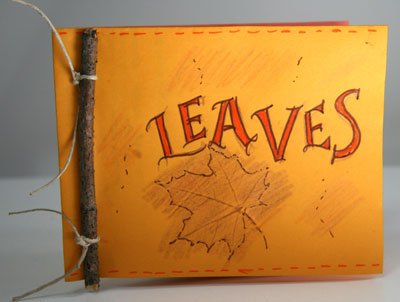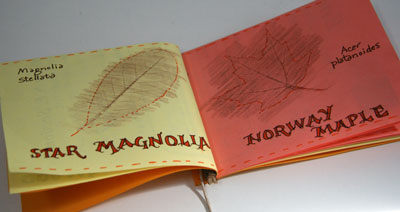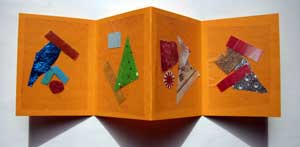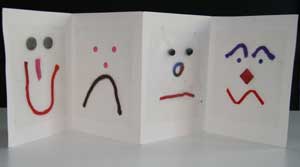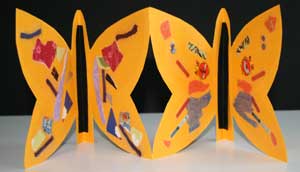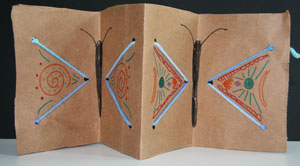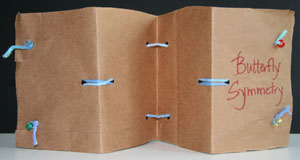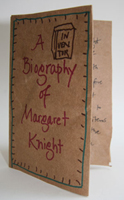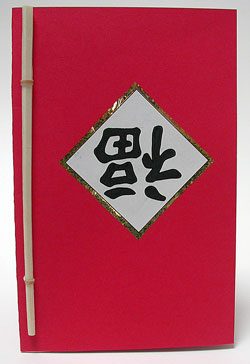 http://www.makingbooks.com/palmleaf.shtml
http://www.makingbooks.com/palmleaf.shtmlThe traditional form of book in India and Southeast Asia is made from the leaves of palm trees. Traditionally the writing and illustration are done with a metal stylus. The writing is scratched into the leaf, after which ink is rubbed over the page and the excess ink is wiped away. Our book is made with a reverse process. The paper is colored with crayons and then painted with black ink. The writing and illustrations are scratched into the paint to reveal the crayon colors.
I used the inside of the front panel of a cereal box. I have found using recycled materials to be very liberating. When you start with a piece that has edges that you have cut yourself, it frees you from worrying about evenness and precision.
Making the Book
You will need one piece of cover stock or one panel of a cereal box, a piece of yarn, and two beads, buttons or the closure tags from bread bags.
1. Color the entire surface with different colored crayons. Paint over the crayon with black poster paint. I used two coats for solid coverage.
2. Hold the paper in front of you vertically. Find the center by eye and push the punch in as far as it will go. Again by eye, cut off a strip so that the punched hole is in the center. You may find it easier to judge if you are looking at the side which does not have the crayon and paint.
3. Use the strip you just made as a guide, and cut up the rest of the paper. Punch a hole in the center of each strip.
4. Follow the directions on the website to complete the book.
5. Do the writing and illustrations with a stick or a bamboo skewer with the pointy ends trimmed off to prevent eye injury.
LinksInformation about Palm Leaf Books
A photo of an illustrated palm leaf book made in Bali from my collection and a text written for children can be found at
http://www.makingbooks.com/booksaroundtheworld.shtmlPhoto of and brief information on a palm leaf book from the library at Cornell.
Click on the photo for a larger image. To explore books from other cultures, go to the Table of Contents. This website offers a concise, well-illustrated journey through books made from paper, leather, clay, and stone.
http://rmc.library.cornell.edu/Paper-exhibit/palmleaf.htmlInformation on the construction of palm leaf books from the Buddha Mind website.
This one is the most direct. Make sure you click on the small images on the left; they will lead you to more images.
http://www.buddhamind.info/leftside/arty/script/leafs.htmThe Preparation of Palm Leaf Documents from the Princely States Report of the Journal of Indian States History, Philately, and Numismatics
This is a bit dry but has good information and illustrations of the styluses used for writing and photos of book pages.
http://princelystates.com/ArchivedFeatures/fa-03-05.shtmlAn article I wrote about Traditional Cambodian Books appeared in the September 1998 issue of
FACES magazine. Each issue of the magazine focuses on a particular culture or topic. With the help of an interpreter, I interviewed the Venerable Sao Khon, the senior monk at the Triratanaram Temple in North Chelmsford, MA for the article.
Books by Artists using the Palm Leaf Book structure
Nigrum by Shu-Ju Wang, Click on the third image down on the left for a full photo and information.
http://fingerstothebone.com/portfolio/nigrum.htmlUnder the Ice by Mia Leijonstedt
http://www.galleriamia.net/ArtBinding8a.htmAdapted from the September 2007 issue of Making Books Monthly
Free subscriptions available at
makingbooks.com






